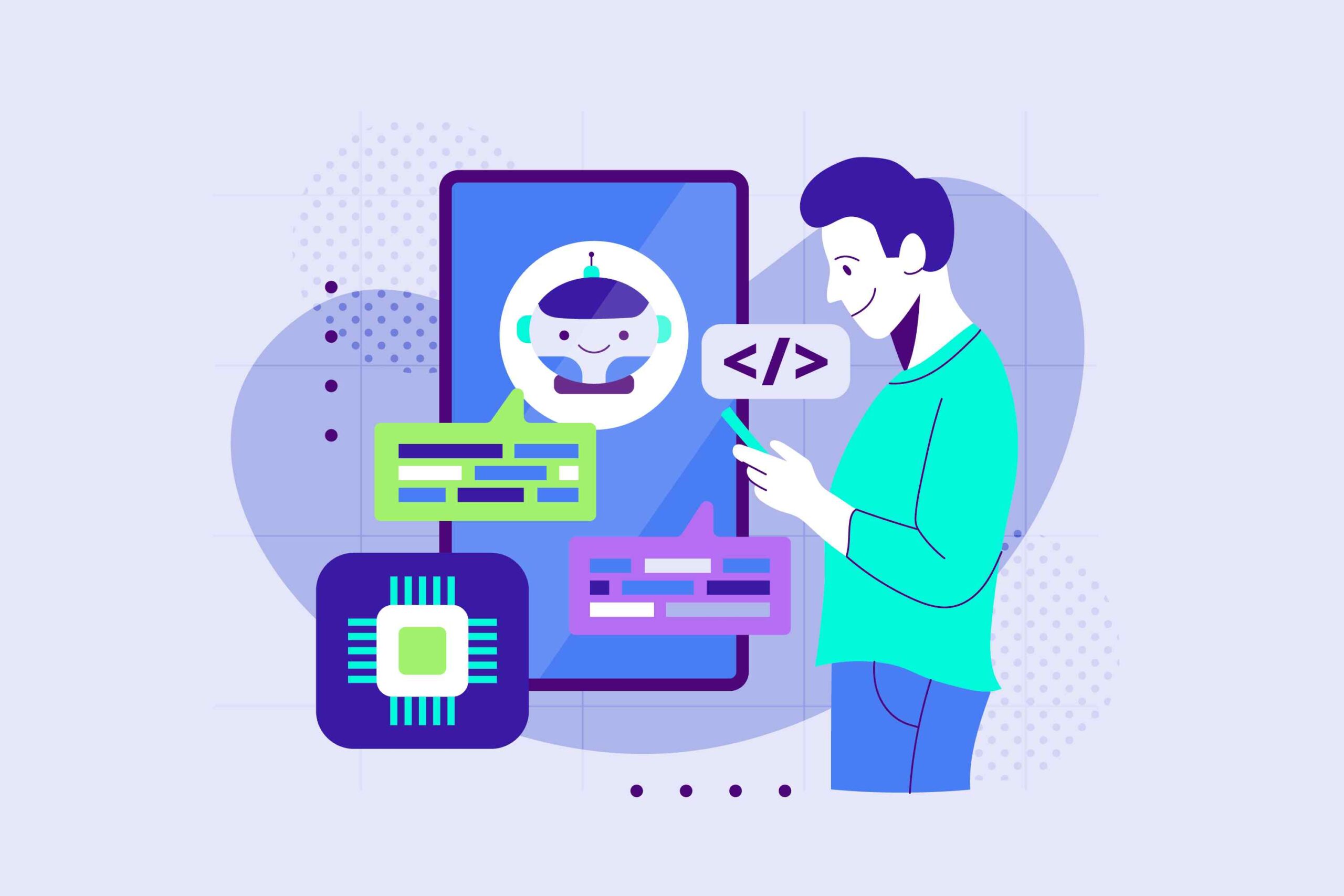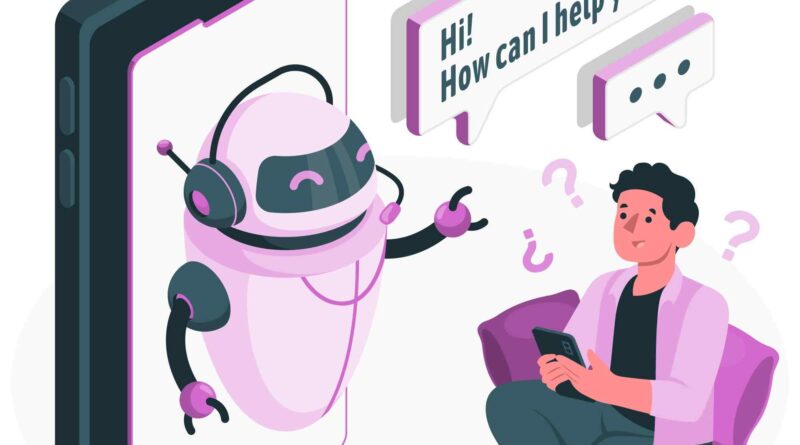Everything about Chatbots And How to Develop Chatbot Using Python
Chatbots have become effective technologies in recent years that improve consumer relations and optimise corporate processes. These sophisticated virtual assistants mimic human communication while providing a range of advantages for different sectors. We’ll delve into the interesting world of chatbots in this blog article, learning about What is a Chatbot, Types of Chatbots Work of Chatbot and How to Develop Chatbot Using Python.
What is a Chatbot
A computer programme called a chatbot, often known as a chat robot, is created to communicate with users through natural language discussions. It uses machine learning and artificial intelligence (AI) to recognize user questions and provide relevant answers. Chatbots are flexible communication tools because they can be implemented into a variety of platforms, including websites, messaging apps, and voice assistants.

Types of Chatbots
Rule-Based Chatbots: Scripted chatbots, sometimes referred to as rule-based chatbots, follow predetermined patterns and rules to function. They have been set up to react to certain user-inputted words or phrases. These chatbots have a structure akin to a decision tree, where each user enquiry results in a pre-planned response. Simple and uncomplicated activities are best handled by rule-based chatbots, which are routinely used in customer support systems to provide quick replies to frequently requested inquiries.
AI-Powered Chatbots: Contrary to rule-based chatbots, AI-powered chatbots replicate human-like conversations using machine learning algorithms and natural language processing (NLP) methods. These chatbots adapt their responses over time as a result of user interactions. They are able to comprehend context, intent, and sentiment, which enables them to give more customised and pertinent solutions. Chatbots that are driven by AI are adaptable and can be used in a variety of settings, including as virtual assistants, language teachers, and individualised shopping assistants.
Virtual Assistant Chatbots: Chatbots are virtual assistants that can help users with chores and give information in a conversational way. They are capable of a wide range of tasks, including as planning events, reminding people to do things, responding to inquiries, and even managing smart home technology. Virtual assistant chatbots, like Apple’s Siri, Amazon’s Alexa, and Google Assistant, have grown in popularity because of their versatility and ability to work with a variety of different programmes and services.
Transactional Chatbots: The main goals of transactional chatbots are to facilitate transactions and assist users with their purchases. They frequently help with the checkout process, offer product recommendations, and respond to queries on e-commerce sites. Transactional chatbots simplify the purchasing process by providing individualised recommendations based on user preferences, past purchases, and browsing activity. These chatbots increase consumer pleasure and boost revenue by facilitating a seamless purchasing experience.
Social Chatbots: Facebook Messenger, WhatsApp, and Slack are just a few examples of the social media platforms where consumers can communicate with chatbots. Businesses use them to interact with clients, offer assistance, and distribute tailored content. Social chatbots take use of the popularity of messaging apps, where users spend a lot of time, to connect with more people. They can respond to inquiries, gather comments, and even carry out surveys, giving firms useful information and enhancing consumer engagement.
Related Content: Role of Python in artificial intelligence
Work of Chatbot
Enhancing Customer Service
Customer service is one of the main industries where chatbots have had a substantial impact. Long wait periods, repetitious questions, and the requirement for human involvement are frequent features of traditional customer service techniques. By offering immediate responses, round-the-clock accessibility, and personalised interactions, chatbots have successfully addressed these issues.
Chatbots can comprehend and interpret client inquiries by utilising natural language processing and machine learning algorithms, supporting customers in getting the information they require quickly and effectively. Chatbots offer quick and reliable service, whether it’s responding to regularly asked inquiries, making product recommendations, or fixing common problems.
Additionally, because chatbots can manage numerous interactions at once, there is no longer a need for customers to wait in lines or for companies to hire a big customer support workforce. Due to the convenience and faster response times, this not only lowers expenses for businesses but also increases customer happiness.
Streamlining Business Operations
Chatbots have proven beneficial in optimising many business procedures in addition to customer service. Internal chatbots, for instance, can help staff members by speeding up information access, streamlining task management, and automating repetitive tasks. Chatbots allow staff to concentrate on more strategic and value-added activities by taking care of administrative tasks like leave requests, expense reporting, or meeting scheduling.
Additionally, chatbots have changed the way that marketing and sales are done. They can have personalised dialogues with potential customers, make suggestions for goods or services based on preferences, and offer on-the-spot support for transactions. Additionally, chatbots are excellent at gathering user data, nurturing leads, and generating leads, all of which eventually increase conversion rates and income.
Elevating User Experience
Chatbots are now an essential component of the user experience landscape thanks to the growth of messaging services and social media. They make it possible for companies to communicate and converse with customers, promoting brand loyalty and forging closer bonds.
Websites, mobile apps, and social media platforms can all be connected with chatbots to give users seamless access to services and assistance. Chatbots produce a user-centric experience that seems personalised and catered to specific needs through personalised recommendations, proactive notifications, and natural language interactions.
Additionally, chatbots may now do more than just communicate via text. Users can have voice conversations with voice-enabled chatbots, which use speech synthesis and recognition to provide a more intuitive and natural interface. This development has made things more convenient and accessible, particularly for people with disabilities or those who prefer voice interactions.
Continuous Learning and Improvement
The ability of chatbots to learn and advance over time sets them unique from conventional software programmes. Chatbots may continuously update their knowledge base, improve their responses, and get better at interpreting human intent by analysing enormous volumes of data and user interactions.
Chatbots may learn from previous talks, adjust to user preferences, and provide information that is more accurate and timely thanks to machine learning algorithms. They enable more empathic and individualised interactions by recognising patterns, anticipating user needs, and even picking up on mood or emotional cues.
Ethical Considerations and Future Directions
Although chatbots provide many advantages, ethical issues also need to be taken into mind. Developers and organisations must take into consideration important factors while designing and implementing chatbots, such as protecting user privacy, ensuring honest communication, and preventing prejudices.
The potential for chatbots in the future is enormous. More advanced chatbots that can comprehend complicated questions, emotions, and context will probably be produced as a result of developments in natural language processing, machine learning, and AI. We should expect greater integration with cutting-edge technologies like virtual reality and augmented reality, which will further improve user experiences.
How to Develop Chatbot Using Python
Prerequisites: Before diving into chatbot development, it’s important to have a basic understanding of Python programming and familiarity with Python libraries such as Flask and Natural Language Processing (NLP) tools like NLTK or spaCy.
Step 1:
the development environment setup Make sure Python is installed on your computer before you do anything else. From the official website (https://www.python.org), you can get the most recent version of Python. Additionally, to keep your project requirements separate, you might wish to build up a virtual environment.
Step 2:
Setting Up Dependencies After setting up your environment, you must install the required libraries and frameworks. Python developers frequently use Flask, NLTK, and ChatterBot to create chatbots. Run the following commands in your terminal to install these dependencies using pip, the Python package installer:
pip install flaskpip install nltkpip install chatterbotStep 3:
Data Collection and Preparation You will require a dataset of conversational data to train your chatbot. Pairs of user inputs and matching bot responses should make up this dataset. You can either generate your own dataset or acquire open-source datasets appropriate for the function of your chatbot. After obtaining the dataset, preprocess it by tokenizing, eliminating stop words, and deleting any extraneous data.
Step 4:
Constructing the chatbot It’s time to start building the chatbot itself now. Start by loading the dataset, initialising the Flask application, and importing the required libraries. Then, employ the NLTK library for tasks including tokenization, stemming, and part-of-speech tagging in natural language processing. Create a ChatterBot chatbot instance after that, then train it using the prepared dataset. Change the logic adapter or language processor, for example, to alter the chatbot’s behaviour.
Step 5:
The creation of the user interface You need a user interface so that you may communicate with your chatbot. It is simple to design a straightforward web-based interface with Flask, a micro web framework for Python. To design a simple and user-friendly interface, define the required routes and render templates using HTML and CSS. Make sure the user inputs are recorded and sent to the chatbot so it can process them.
Step 6:
Use of the Chatbot After testing your chatbot locally, you might decide to upload it to a server or cloud platform so that users can access it. Python application deployment options include Heroku, AWS, or Azure. Make sure all required dependencies are installed, then adjust your deployment settings.
Conclusion
The way we engage with technology has been revolutionised by chatbots, which also improve efficiency across industries and the consumer experience. Virtual assistants driven by AI and rule-based chatbots both have their own distinct characteristics and advantages. We may anticipate that chatbots will grow much more smart as technology develops, capable of comprehending difficult questions and offering human-like dialogues. Businesses may use these intelligent conversational bots to improve interactions with their consumers and streamline operations by utilising chatbot applications, which have a bright future. In the digital sphere, chatbots have shown to be a game-changer, revolutionising how organisations interact, offer customer service, and streamline operations. The client experience has been transformed by their capacity to provide immediate assistance, individualised interactions, and ongoing learning. We may anticipate further developments in chatbot technology that will influence communication in the future and spur innovation across industries. Python-based chatbot development offers a flexible and potent way to automate discussions and enhance user experiences. You may build a useful and engaging chatbot that is tailored to your particular needs using the appropriate tools and frameworks, such as Flask, NLTK, and ChatterBot. Remember to obtain user feedback and update your chatbot’s training data as you iterate and improve it. So go ahead and explore the world of Python chatbot creation to discover new opportunities for your professional or personal projects.


